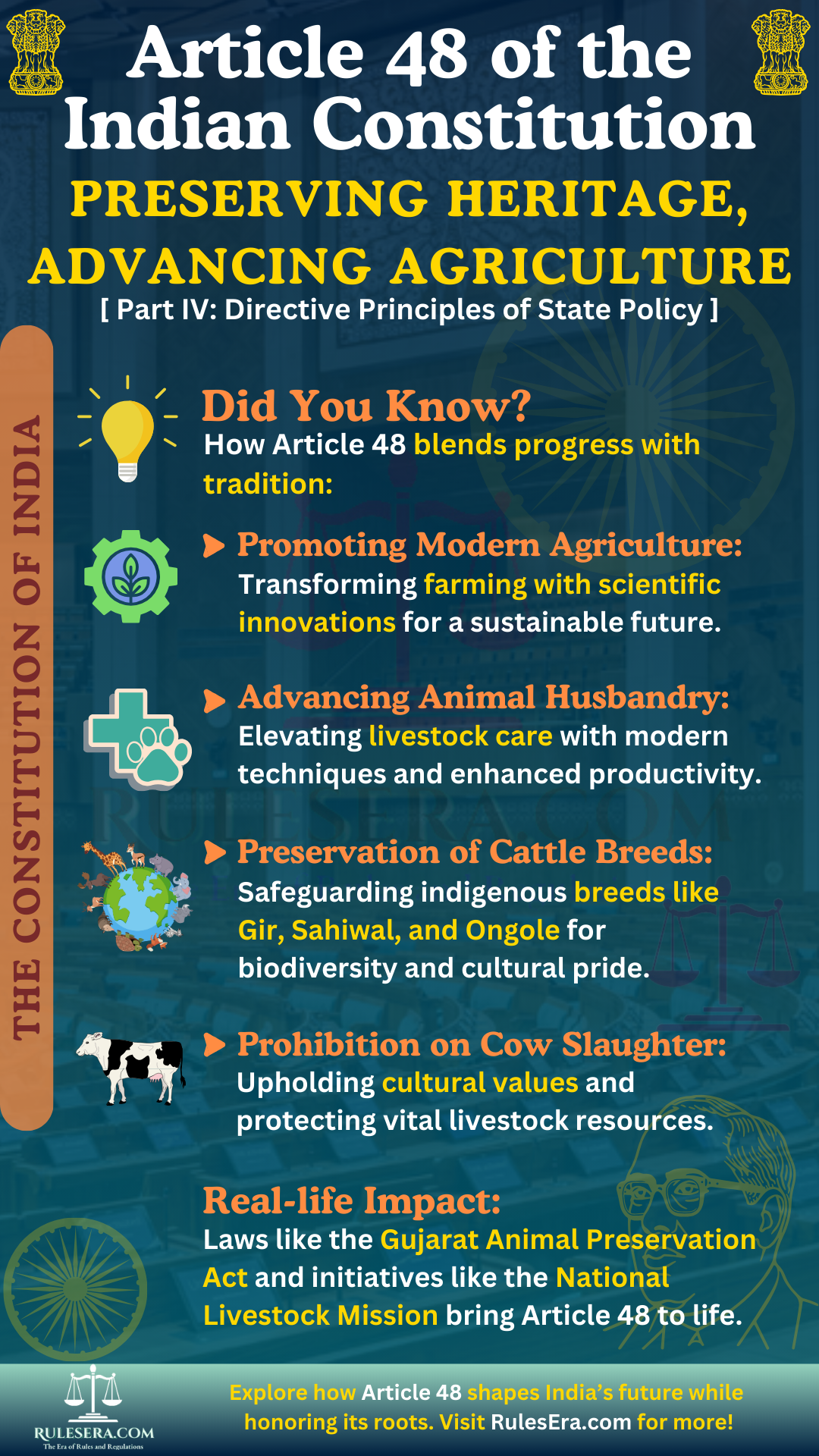Part IV: Directive Principles of State Policy
Article 48: Organisation of Agriculture and Animal Husbandry

--- Original Article ---
The State shall endeavour to organise agriculture and animal husbandry on modern and scientific lines and shall, in particular, take steps for preserving and improving the breeds, and prohibiting the slaughter, of cows and calves and other milch and draught cattle.
Explanation
Article 48 of the Indian Constitution mandates the State to organize both agriculture and animal husbandry using modern, scientific methods. The article emphasizes not only economic development through science but also the protection of cultural values, especially in the preservation of cattle breeds and the prohibition of cow slaughter.
Promoting Scientific Agriculture
The article encourages the State to modernize agricultural practices through scientific advancements, aiming to improve productivity, sustainability, and food security across the country.
Developing Animal Husbandry with Modern Techniques
Animal husbandry, too, is to be enhanced using modern techniques such as selective breeding and better veterinary care, improving the productivity of livestock and benefiting the rural economy.
Preservation and Improvement of Cattle Breeds
The article specifically calls for the protection and improvement of indigenous cattle breeds, ensuring their continued economic and cultural importance.
Ban on Slaughter of Cows and Draught Animals
Article 48 directs the State to prohibit the slaughter of cows, calves, and other milch and draught cattle, reflecting the cultural reverence for cows and their economic importance in rural areas.
Amendments and Real-Life Examples
- No amendments: There have been no constitutional amendments directly related to Article 48. However, laws like the Gujarat Animal Preservation (Amendment) Act, 2011 align with its objectives by penalizing cow slaughter.
- National Livestock Mission: The establishment of programs such as the National Livestock Mission reflects the scientific principles of Article 48 by improving cattle breeds and livestock productivity.
Historical Significance
Article 48 represents a balance between modern agricultural practices and the cultural values embedded in Indian society. The protection of cows, in particular, is a reflection of India's agrarian traditions and religious reverence, while the focus on scientific farming and animal husbandry underscores the nation’s need for economic progress.
Legislative History
On November 24, 1948, Pandit Thakur Das Bhargava from East Punjab proposed a new article, originally designated as Article 38-A, which was later incorporated as Article 48 in the Constitution of India.
Debates and Deliberations
In the Constituent Assembly debate regarding Article 38-A, Pandit Thakur Das Bhargava proposed an amendment aimed at organizing agriculture and animal husbandry on modern and scientific lines. His amendment emphasized the preservation and improvement of cattle breeds, particularly milch and draught cattle, while prohibiting cow slaughter. Bhargava argued that protecting cattle was essential for the country's agricultural and economic growth, particularly in addressing the food crisis and enhancing milk production. He noted that India had historically relied on its cattle wealth and that, despite government efforts, cattle numbers were decreasing, which was alarming given the dependence on oxen for plowing and cows for milk. Bhargava referenced historical instances, including Muslim rulers like Akbar and Aurangzeb, who had banned cow slaughter for economic reasons, asserting that cow protection was both a cultural and practical necessity for the nation.
Seth Govind Das, supporting Bhargava’s proposal, moved an amendment to further expand the definition of "cow" to include bulls, bullocks, and calves, emphasizing that no cow, whether useful or not, should be slaughtered. He linked cow protection to India's cultural and religious heritage, citing Hindu traditions and figures like Lord Krishna and historical Muslim rulers who prohibited cow slaughter. He argued that cow protection was not merely a religious concern but also an economic and agricultural imperative, pointing to declining cattle numbers and the importance of milk in combating malnutrition.
Muslim members, such as Syed Muhammad Saiadulla and Z.H. Lari, expressed concern that the issue of cow protection could lead to misunderstandings between religious communities. Lari emphasized that while Islam permits the sacrifice of cows during certain religious festivals, it does not mandate it, and suggested that the issue be resolved clearly in the Constitution to avoid conflict. Saiadulla highlighted the economic challenges posed by prohibiting cow slaughter, particularly in regions like Assam, where cattle are often uneconomical and need to be replaced with better breeds.
Ultimately, Bhargava's amendment, which sought to organize agriculture and animal husbandry along scientific lines while prohibiting cow slaughter, was accepted. Govind Das’s further amendment to expand the definition of "cow" was rejected, and Article 38-A, as amended by Bhargava, was added to the Constitution. This provision reflects a compromise, balancing economic and cultural concerns with a directive to protect and improve the country's cattle wealth.
Frequently Asked Questions (FAQs):
Article 48 focuses on organizing agriculture and animal husbandry using modern, scientific techniques while also emphasizing the protection of cattle breeds, especially cows, calves, and draught cattle.
Programs like the National Livestock Mission and state-level laws such as the Gujarat Animal Preservation (Amendment) Act, 2011 reflect the goals of Article 48, focusing on cattle protection and improving livestock productivity.